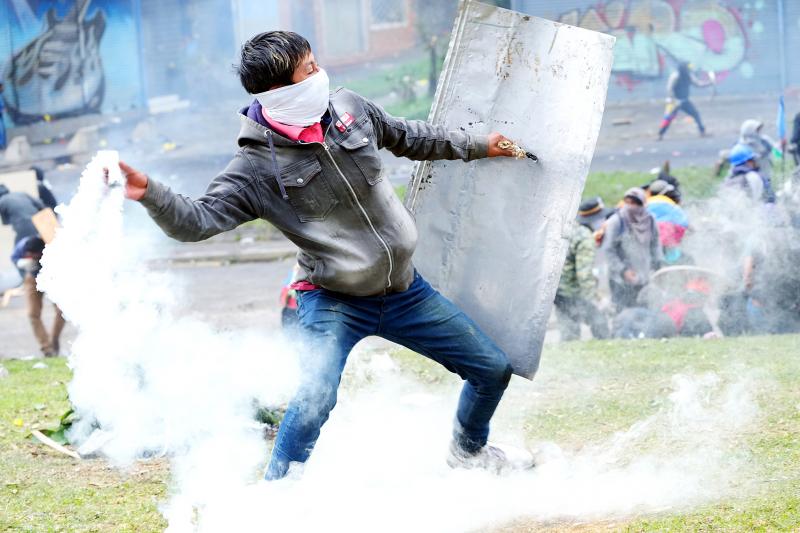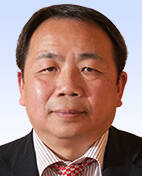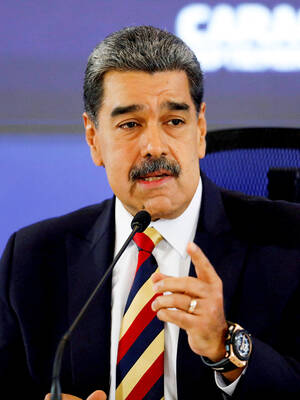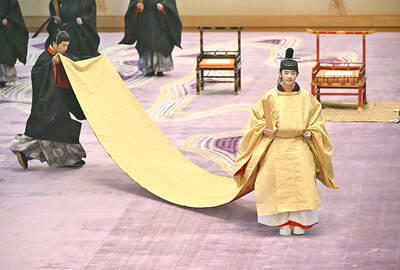Violent clashes between indigenous protesters and police broke out for a second straight day on Friday in Ecuador’s capital, as the country’s president accused demonstrators of attempting a coup.
Nearly two weeks into protests that have left six people dead and dozens injured, thousands of demonstrators angry at rising fuel prices threw rocks and Molotov cocktails and shot off fireworks near the congress building in Quito.
Security forces repelled protesters with tear gas, and clashes eventually stopped late in the evening, Agence France-Presse reporters on the scene said.

Photo: AP
“The real intention of these violent people is to stage a coup,” Ecuadorian President Guillermo Lasso said in a speech earlier on Friday in which he again offered dialogue to end the protests.
An estimated 14,000 protesters are taking part in a nationwide show of discontent against rising hardships in an economy dealt a serious blow by the COVID-19 pandemic.
Most of the ire is concentrated in the capital Quito, where about 10,000 people, most from other parts of the country, have gathered.
Both sides accused each other of intransigence on Friday, as the protests entered their 12th day.
“They have unmasked themselves. They don’t want to negotiate. They don’t want to come to an agreement... They don’t want peace. Until now, the only thing they have demonstrated is that they want violence,” Ecuadoran Minister of Government Francisco Jimenez told broadcaster FM Mundo.
Six of the country’s 24 provinces are under a state of emergency and a night-time curfew is in place in Quito.
Protesters are demanding a cut in already subsidized fuel prices, which have risen sharply in the past few months, as well as jobs, food price controls, and more public spending on healthcare and education.
However, the action has been costly, with losses of about US$50 million per day to the economy, and production of fuel — Ecuador’s biggest export — halved, the Ministry of Energy and Non-Renewable Natural Resources said.
On Thursday, protesters won a limited concession from Lasso who granted them access, “for the sake of dialogue and peace,” to a cultural center emblematic of the indigenous struggle that had been commandeered by police.
However, hours later a group of protesters headed for the Ecuadorian Congress, where police fired tear gas in response to a barrage of rocks, fireworks and Molotov cocktails.
Three people died in confrontations on Thursday, bringing the toll to six since the movement started on June 13 on the initiative of the powerful Confederation of Indigenous Nationalities of Ecuador (CONAIE).
CONAIE leader Leonidas Iza said that the revolt would continue “until we have results. We can no longer hold back the anger of the people.”
People are desperate, Iza said.
“We expected the president to answer the central questions of the crisis, the poverty our people are experiencing. The economic question is one of despair, which is why we are here,” he said. “There is a lot of poverty, the increase in the price of fuel has increased all the prices, and we, the poorest, are the ones who suffer the most.”

China on Monday announced its first ever sanctions against an individual Japanese lawmaker, targeting China-born Hei Seki for “spreading fallacies” on issues such as Taiwan, Hong Kong and disputed islands, prompting a protest from Tokyo. Beijing has an ongoing spat with Tokyo over islands in the East China Sea claimed by both countries, and considers foreign criticism on sensitive political topics to be acts of interference. Seki, a naturalised Japanese citizen, “spread false information, colluded with Japanese anti-China forces, and wantonly attacked and smeared China”, foreign ministry spokesman Lin Jian told reporters on Monday. “For his own selfish interests, (Seki)

VENEZUELAN ACTION: Marco Rubio said that previous US interdiction efforts have not stemmed the flow of illicit drugs into the US and that ‘blowing them up’ would US President Donald Trump on Wednesday justified a lethal military strike that his administration said was carried out a day earlier against a Venezuelan gang as a necessary effort by the US to send a message to Latin American cartels. Asked why the military did not instead interdict the vessel and capture those on board, Trump said that the operation would cause drug smugglers to think twice about trying to move drugs into the US. “There was massive amounts of drugs coming into our country to kill a lot of people and everybody fully understands that,” Trump said while hosting Polish President

Japan yesterday heralded the coming-of-age of Japanese Prince Hisahito with an elaborate ceremony at the Imperial Palace, where a succession crisis is brewing. The nephew of Japanese Emperor Naruhito, Hisahito received a black silk-and-lacquer crown at the ceremony, which marks the beginning of his royal adult life. “Thank you very much for bestowing the crown today at the coming-of-age ceremony,” Hisahito said. “I will fulfill my duties, being aware of my responsibilities as an adult member of the imperial family.” Although the emperor has a daughter — Princess Aiko — the 23-year-old has been sidelined by the royal family’s male-only

A French couple kept Louise, a playful black panther, in an apartment in northern France, triggering panic when she was spotted roaming nearby rooftops. The pair were were handed suspended jail sentences on Thursday for illegally keeping a wild animal, despite protesting that they saw Louise as their baby. The ruling follows a September 2019 incident when the months-old feline was seen roaming a rooftop in Armentieres after slipping out of the couple’s window. Authorities captured the panther by sedating her with anesthetic darts after she entered a home. No injuries were reported during the animal’s time on the loose. The court in the